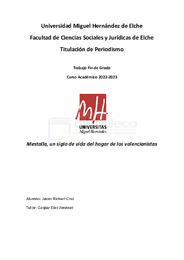Por favor, use este identificador para citar o enlazar este ítem:
https://hdl.handle.net/11000/29881Registro completo de metadatos
| Campo DC | Valor | Lengua/Idioma |
|---|---|---|
| dc.contributor.advisor | Díez Jiménez, Gaspar | - |
| dc.contributor.author | Richart Cruz, Javier | - |
| dc.contributor.other | Departamentos de la UMH::Ciencias Sociales y Humanas | es_ES |
| dc.date.accessioned | 2023-10-30T12:17:39Z | - |
| dc.date.available | 2023-10-30T12:17:39Z | - |
| dc.date.created | 2023-06 | - |
| dc.identifier.uri | https://hdl.handle.net/11000/29881 | - |
| dc.description.abstract | Mestalla ha sido la casa de los valencianistas desde 1923. En este estadio los aficionados blanquinegros, y también de la Selección Española, han vivido momentos inolvidables. Hace 100 años que el Valencia CF dejó el campo de Algirós para trasladarse a un hogar nuevo con más capacidad. Durante este siglo de historia, Mestalla ha sufrido transformaciones obligadas, como la reforma tras la Guerra Civil o la riada de 1957. Incluso, hubo un tiempo en el que Mestalla dejó de llamarse Mestalla. Entre 1969 y 1994 se llamó Estadio Luis Casanova, un homenaje para uno de los mejores presidentes de la historia del club. Además, el feudo valencianista fue la casa de la Selección Española en el Mundial de España en 1982, ya que allí se disputaron los encuentros de la Roja durante la fase de grupos. Y 10 años más tarde, volvió a acoger los partidos del combinado nacional, pero en los Juegos Olímpicos de Barcelona en 1992. Mestalla tiene rincones muy especiales para todas las personas que han pasado por el estadio. En especial, hay uno que Ricardo Arias, segundo jugador con más partidos del club, considera especial: “La capilla. Allí tenemos a nuestra virgen a la que suelo visitar siempre que puedo. Cuando era jugador la visitaba cada uno de los partidos que jugaba en Mestalla”. Aunque suene duro, este centenario no se tendría que haber celebrado. En 2007 se inició la construcción del Nuevo Mestalla, que tenía prevista su inauguración en 2010. Sin embargo, 13 años después esa obra aún sigue paralizada a falta de un entendimiento entre el Valencia CF y el Ayuntamiento de Valencia. El significado de Mestalla para los aficionados del conjunto che es tal que ha dejado anécdotas increíbles. Una de ellas es la de Vicente Navarro, quien a pesar de quedarse ciego a los 54 años, siguió yendo al estadio, donde su hijo le narraba los partidos. Un sentimiento indescriptible, como asegura Ricardo Arias: “Para nosotros, Mestalla son palabras mayores. No se puede definir”. | es_ES |
| dc.description.abstract | Mestalla has been the home of the Valencianistas since 1923. In this stadium the black and white fans, and also the Spanish National Team, have experienced unforgettable moments. 100 years ago Valencia CF left the Algirós field to move to a new home with more capacity. During this century of history, Mestalla has undergone forced transformations, such as the reform after the Civil War or the flood of 1957. There was even a time when Mestalla stopped being called Mestalla. Between 1969 and 1994 it was called the Luis Casanova Stadium, a tribute to one of the best presidents in the club's history. In addition, the Valencian fiefdom was the home of the Spanish National Team in the World Cup in Spain in 1982, since the matches of La Roja were played there during the group stage. And 10 years later, it again hosted the matches of the national team, but at the Barcelona Olympic Games in 1992. Mestalla has very special corners for all the people who have passed through the stadium. In particular, there is one that Ricardo Arias, the second player with the most appearances for the club, considers special: “The chapel. There we have our virgin whom I usually visited whenever I could. When I was a player, I visited her each of the games he played at Mestalla ”. Although it sounds harsh, this centenary should not have been celebrated. In 2007 the construction of the New Mestalla began, which was scheduled to open in 2010. However, 13 years later that work is still paralyzed due to the misunderstanding between Valencia CF and the Valencia Town Hall. The meaning of Mestalla for che team fans is such that it has left incredible anecdotes. One of these anecdotes is one from Vicente Navarro, who despite going blind at the age of 54, continued going to the stadium, where his son narrated all the matches for him. An unspeakable feeling, as Ricardo Arias says: “For us, Mestalla means big words. It cannot be defined”. | es_ES |
| dc.format | application/pdf | es_ES |
| dc.format.extent | 26 | es_ES |
| dc.language.iso | spa | es_ES |
| dc.publisher | Universidad Miguel Hernández de Elche | es_ES |
| dc.rights | info:eu-repo/semantics/openAccess | es_ES |
| dc.rights | Attribution-NonCommercial-NoDerivatives 4.0 Internacional | * |
| dc.rights.uri | http://creativecommons.org/licenses/by-nc-nd/4.0/ | * |
| dc.subject | Mestalla | es_ES |
| dc.subject | Valencia | es_ES |
| dc.subject | sentiment | es_ES |
| dc.subject | centenario | es_ES |
| dc.subject | Luis Casanova | es_ES |
| dc.subject | Feeling | es_ES |
| dc.subject | Centenary | es_ES |
| dc.subject.other | CDU::0 - Generalidades.::070 - Periódicos. Prensa. Periodismo. Ciencias de la información | es_ES |
| dc.title | Mestalla, un siglo de vida del hogar de los valencianistas | es_ES |
| dc.type | info:eu-repo/semantics/bachelorThesis | es_ES |

Ver/Abrir:
MEMORIA FINAL TFG JAVIER RICHART UMH.pdf
4,04 MB
Adobe PDF
Compartir:
 La licencia se describe como: Atribución-NonComercial-NoDerivada 4.0 Internacional.
La licencia se describe como: Atribución-NonComercial-NoDerivada 4.0 Internacional.
.png)